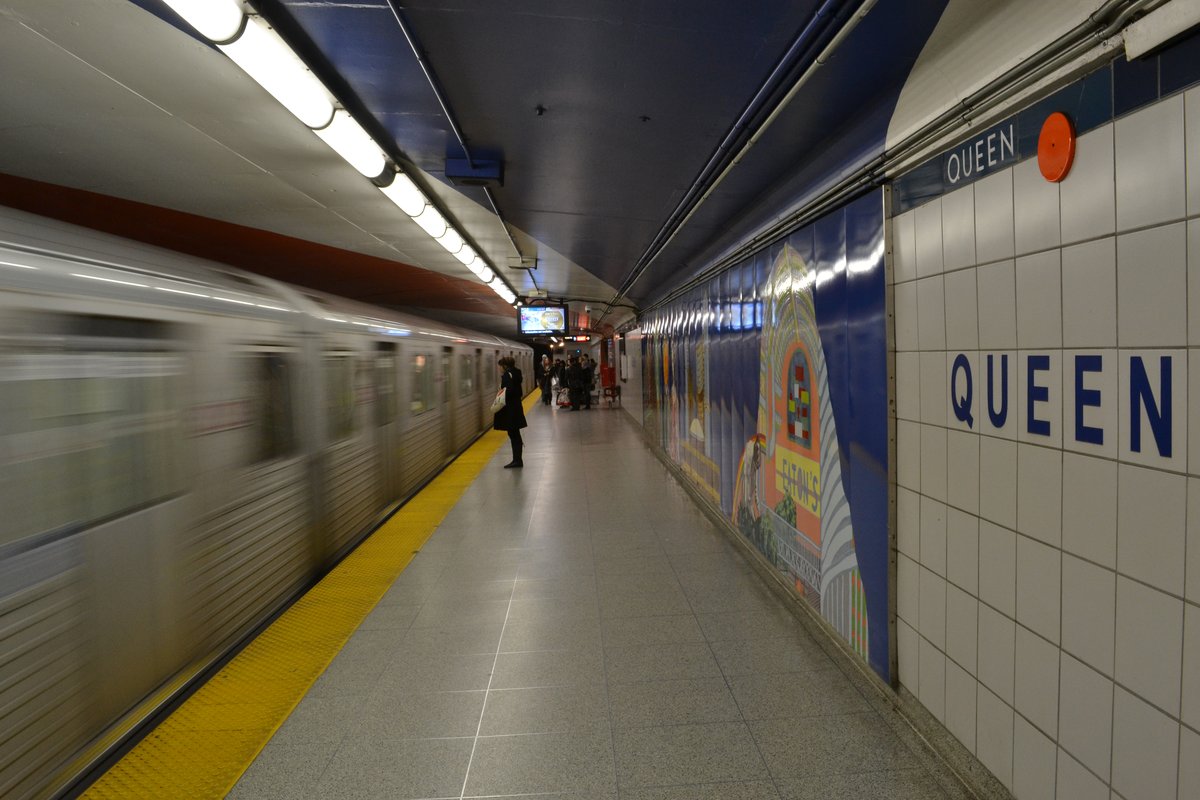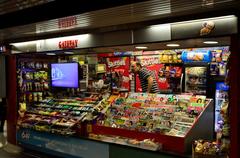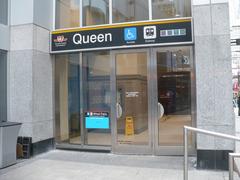
Queen Street Toronto Visiting Hours, Tickets, and Historical Sites Guide
Date: 15/06/2025
Introduction
Queen Street Toronto is an essential artery in the city’s urban fabric, representing a fusion of rich historical heritage, architectural splendor, and contemporary culture. Once an Indigenous trail and later known as Lot Street during the colonial era, Queen Street has borne witness to Toronto’s evolution from its earliest settlements to its status as a global metropolis. Today, Queen Street is celebrated for its preserved Victorian and Edwardian architecture, vibrant arts and music scenes, eclectic shopping, and diverse culinary offerings (Ontario Away, Toronto Heritage Conservation District Plan). This guide provides visitors with historical context, practical travel details, and insights into Queen Street’s key attractions, making it the perfect companion for exploring one of Toronto’s most dynamic corridors.
Historical Overview of Queen Street Toronto
Indigenous Roots and Early Settlement
Long before European settlement, the land that is now Queen Street was home to Indigenous peoples, notably the Mississaugas of the Credit and other Anishinaabe nations. It served as a vital trail linking Lake Ontario to the broader Ontario interior (Ontario Away). In 1793, John Graves Simcoe, Lieutenant Governor of Upper Canada, established York (later Toronto), and the area was parceled into large tracts for colonial development (Toronto City Council PDF).
From Lot Street to Queen Street
Originally named Lot Street, the thoroughfare was central to York’s urban grid and planning. It was later renamed Queen Street in honor of Queen Victoria, reflecting the city’s British colonial ties (Toronto Heritage Conservation District Plan). With the annexation of Riverdale in 1884 and systematic renumbering, Queen Street quickly evolved into a commercial and residential hub, catalyzed by the introduction of the streetcar (MapTurners).
Architectural Heritage
The late 19th and early 20th centuries marked a boom in construction along Queen Street, producing landmark buildings such as the James M. Purvis building (666 Queen St. E.), and the Broadview Hotel, both of which remain symbols of Toronto’s prosperity and ambition (Toronto.com). These structures, with their ornate brickwork and period details, are vital to the street’s historical identity.
Urban Growth and Preservation
Queen Street’s growth was largely shaped by the expansion of Toronto’s streetcar network, which fostered connectivity between neighborhoods and encouraged urban density. Today, many Queen Street properties are protected under Toronto’s Heritage Register, and adaptive reuse projects—such as the Broadview Hotel—have successfully merged historical preservation with modern amenities (Toronto2Anywhere).
Cultural and Artistic Influence
Queen Street West, in particular, is synonymous with creativity and innovation. The area is home to renowned live music venues like the Horseshoe Tavern and creative landmarks such as Graffiti Alley, a vibrant expanse of legal street art (TripSavvy). Community festivals, such as the Beaches Jazz Festival and the Nuit Blanche art celebration, reinforce Queen Street’s reputation as a cultural epicenter (Toronto2Anywhere).
Visiting Queen Street Toronto: Practical Information
Public Access and Venue Hours
- Queen Street: Open 24/7 as a public roadway.
- Shops, Galleries, and Restaurants: Generally open from 10:00 AM to 9:00 PM. Nightlife venues operate late into the evening.
- Museums and Theatres: Hours vary; check individual websites for current information.
Tickets and Admission
- Street Access: Free and open to all.
- Attractions: Most historic sites and street art are accessible without charge. Some events, concerts, and exhibitions require advance ticket purchase. Always verify with the venue or event organizer.
Guided Tours and Tips
Guided walking tours are available through local operators and highlight Queen Street’s history, street art, and cultural landmarks. The 501 Queen streetcar is the main transit route serving the entire length of Queen Street, making it easy to explore multiple neighborhoods in a single day.
Accessibility
Queen Street features wide sidewalks and accessible transit options. Although many businesses are wheelchair friendly, some historic buildings may have limited access—always check with venues in advance if accessibility is a concern.
Recommended Photography Spots
- Graffiti Alley: For colorful street art.
- Broadview Hotel Rooftop: Offers panoramic views of the skyline.
- Victorian Architecture: Along Queen Street East and West, perfect for capturing historic facades.
Exploring Queen Street’s Districts and Key Landmarks
Queen Street East: The Beaches and Leslieville
- The Beaches: A scenic lakeside area with boardwalks, independent shops, and summer festivals.
- Leslieville: Once industrial, now a hotspot for brunch, vintage shopping, and creative businesses.
- History Toronto (1663 Queen St E): A major live event venue—check event schedules and tickets for details.
Queen Street West: Arts, Fashion, and Nightlife
- Downtown Core: Close to Yonge Street, major shopping and cultural institutions are easily accessed.
- Fashion District: Former textile hub, now filled with designer boutiques and nightlife.
- West Queen West: Recognized as one of the world’s trendiest neighborhoods, boasting art galleries, Graffiti Alley, and the historic 999 Queen Street West building (former Provincial Lunatic Asylum; exterior viewing only).
- Trinity Bellwoods Park: A popular green space for picnics, seasonal events, and relaxation.
- Ossington Avenue: Vibrant nightlife, acclaimed restaurants, and unique shops.
Parkdale and Beyond
- Parkdale: Known for its multicultural dining, vintage shops, and resilient community spirit.
Queen Street West: Visiting Hours, Attractions, and Tips
Graffiti Alley
- Hours: Open 24/7
- Admission: Free
- Tip: Visit during daylight for the best photography (Streets of Toronto).
Trinity Bellwoods Park
- Hours: 6:00 AM – 12:00 AM daily
- Events: Seasonal markets and community festivals (ToDoCanada).
401 Richmond
- Address: 401 Richmond St W
- Hours: Tuesday–Saturday, 11:00 AM–6:00 PM (varies by tenant)
- Admission: Free (Doors Open Ontario)
Indie Boutiques and Food Scene
- Shops: Generally open 11:00 AM–7:00 PM; hours vary.
- Dining: Options range from bistros to plant-based restaurants and international cuisine. Notable stops include La Palette (French), Terroni (Italian), and Planta Queen (vegetarian/vegan).
Live Music and Art Venues
- The Horseshoe Tavern, Rivoli, and Cameron House: Check websites for show schedules and ticketing.
- Galleries: Many are free or have a nominal fee; Doors Open Toronto in May offers access to additional sites.
Events and Seasonal Highlights
Queen Street hosts a variety of festivals and events throughout the year, including the Beaches International Jazz Festival, Nuit Blanche, outdoor art walks, and artisan markets (AllEvents Toronto). Check local listings and venue websites for details.
Transit and Accessibility
- 501 Queen Streetcar: Connects all major districts along Queen Street.
- TTC Subway: Intersects at Yonge and other key points.
- Parking: Limited; public transit is recommended for convenience.
- Accessibility: Most modern venues and transit options are accessible.
Frequently Asked Questions (FAQ)
Q: What are Queen Street Toronto’s visiting hours?
A: The street is open 24/7. Most businesses operate 10:00 AM–9:00 PM; check with venues directly for specifics.
Q: Are tickets required?
A: No for general exploration; yes for concerts, theatre, and some exhibitions.
Q: How do I get there by public transit?
A: The 501 Queen streetcar is the primary route.
Q: Is Queen Street accessible?
A: Most areas are accessible, but some older buildings may have limitations.
Q: Are guided tours available?
A: Yes; local operators offer seasonal history, art, and food tours.
Visual and Media Suggestions
- Images: Feature historic architecture, Graffiti Alley murals, Trinity Bellwoods Park, and bustling street scenes.
- Alt Text: Use descriptive labels such as “Queen Street West Toronto graffiti murals” and “Trinity Bellwoods Park picnic area.”
- Interactive Map: Highlight major attractions and transit stops.
Summary of Key Points
Queen Street Toronto is a living narrative of the city’s layered history, diverse cultures, and creative dynamism. From its Indigenous origins to its modern incarnation as Toronto’s premier cultural corridor, Queen Street offers preserved architecture, world-renowned art, eclectic shopping, and vibrant festivals (Toronto Heritage Conservation District Plan, Ontario Away). With seamless transit access, guided tours, and a welcoming urban environment, the street invites visitors to immerse themselves in Toronto’s past, present, and future (Toronto City Council PDF, Twirl the Globe Guide).
Call to Action
Ready to discover Toronto’s most iconic street? Download the Audiala app for curated tours, live event updates, and insider guides. Explore our related articles on Toronto’s neighborhoods and follow us on social media for the latest tips and inspiration. Plan your Queen Street adventure and experience the heart of the city’s history and culture!
Sources
- Ontario Away, Visiting Toronto for the First Time
- Toronto City Council, Heritage Background File
- Toronto Heritage Conservation District Plan
- Toronto.com, Preserving the Heritage Character of Queen St E
- Twirl the Globe Guide, Queen Street Toronto
- Destination Toronto, Queen West Neighbourhood
- History Toronto, Events and Tickets
- MapTurners, Toronto Guide
- Toronto2Anywhere, Things to Do in Toronto
- AllEvents Toronto, Events Calendar
- Audiala, Mobile App for Tours






























































































































































































